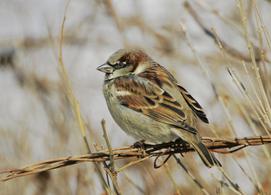HOUSE SPARROW KY-104
Lincoln Homestead State Park, Springfield, Kentucky
May 31, 8:24 a.m.
Sunrise at 6:21 a.m.
For a little over two and a half minutes, a male house sparrow sings from the TV antenna atop the log cabin here at Lincoln Homestead State Park. It's a noisy environment, and I've cleaned up the recording a little so that all of the traffic noise and lawn mowers and humming soda machine aren't too intrusive--but what is a house sparrow without all of those man-made background sounds?
What a wonderful variety of cheeps and chirrups he offers here, each a quarter second or less, initially at the clip of almost two per second, well over 100 per minute. My ears cannot begin to catch glimpses of how many songs he sings here, but my eyes are far better when I study the sonagrams. I pick out what looks like a reasonably distinctive song, the fourth one at 0:02.6, and then I look for it again--sure enough, there it is again, at 0:04.5, then 0:07, and more. I count songs from the beginning, noting where in the song sequence this particular song occurs: 4, 6, 10, 15, 20, 25, 30, 35, 42, 50, 60 (at 0:34.6), and I don't see it in the remainder of the 213 "songs" here. It has disappeared.
Intrigued, I pick another song, this one simpler, first heard at 0:21. I count for this song, too, 24, 29, 33, 36, 41, 44, 48, 51, 54, 59, 62, 65, 70 . . . 117, 121 . . . 195, 200, 204, 208, 211. Fascinating. He used this song on three different "occasions," in three different clusters.
Suppose that these two songs are representative of how often his other songs are used. The first song occurred 11 times, the second 20 times, for an average of 15.5 times. With 213 total songs, each different song occurring about 15.5 times, that's an estimate of 213/15.5 = 14 different songs that he's used in this performance. It's a bit humbling to know all that he can do and how little my ears can actually hear.
Anyone who wanted to better understand the mind of this house sparrow would drool at the thought of a far longer sequence of songs from this male. When do these two songs occur in the longer sequence? What other songs might be studied? You may have guessed it: I have just such a long, unabridged recording, but it's a bit ugly by some aesthetic standards, with cars passing and making lots of noise. For someone intrigued by these songs, however, the traffic noise is irrelevant, and the longer recording offers all kinds of opportunities for play. It begins with the same 213 songs as this recording (KY-104), but then continues on for over nine minutes.
Background
American robin, northern cardinal, eastern wood-pewee, house finch, Baltimore oriole, warbling vireo.

Photo by John Van de Graaff
